With the KEAM mock test free, you can develop the problem-solving skills that are necessary to excel in the exam. Additionally, you will be able to understand the topics that carry high weightage and study them accordingly during your preparation journey.
Kerala Engineering, Architecture, and Medical Entrance Exam Highlights
KEAM is a highly competitive state-level examination that provides admission into various undergraduate courses in educational institutes around Kerala. You can go through the table given below for the main highlights of this exam.
|
ASPECT |
DETAILS |
|
Examination Name |
KEAM: Kerala Engineering, Architecture, and Medical Entrance Exam |
|
Exam Regulating Organization |
CEE: Office of the Commissioner for Entrance Examinations, Kerala |
|
Examination Level |
State-level exam |
|
Mode of the Examination |
Online: Computer-Based Test in 2024 |
|
Number of Sections in Engineering Entrance Exam |
Three
|
|
Types of Questions |
Objective type multiple-choice questions (5 suggested answers would be given for each question, out of which only 1 would be correct). |
|
Section-Wise Number of Questions |
|
|
Total Duration of the Exam |
180 minutes |
|
Total Marks |
300 marks |
|
Marking Scheme Followed |
|
|
Official Website |
KEAM Mock Test Free Available For Different Sections
You can explore the KEAM mock test 2025 for different sections of the exam on our platform. We create the test series in a section-wise format so that you can strengthen your conceptual knowledge of each topic significantly. By engaging with these mock tests one by one, you can easily learn about the areas where you excel or require more practice. Then, you can make changes to your study plan for effective exam preparation.
Solutions For The Questions Of KEAM Mock Test 2025
SelfStudys offers you correct solutions for all the questions included in the KEAM online mock test. Once you have attempted the test completely, you can verify your responses with the provided solutions and check your accuracy level. By doing so, you can dedicate more time to the topics in which your concepts are still unclear. You will be able to improve your mistakes over time and can avoid them in the actual exam efficiently.
What Is The Method To Attempt The KEAM Online Mock Test On SelfStudys?
The method with which you can easily attempt the KEAM mock test series is mentioned with all the details in this section. You can follow the below-given steps to complete the attempting method on our platform.
- www.selfstudys.com is the URL of our website. You can type this in the search section of your favorite internet browser.

- The homepage of our website will showcase a ‘Navigation Bar’ at the top-left corner. You have to click on this icon to open our main menu.
- Then, you can select the ‘JEE’ section from the list in order to move forward in the process.
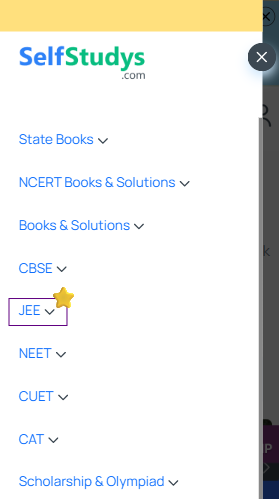
- You have to now click on the ‘KEAM mock test’ option from the other available study resources.
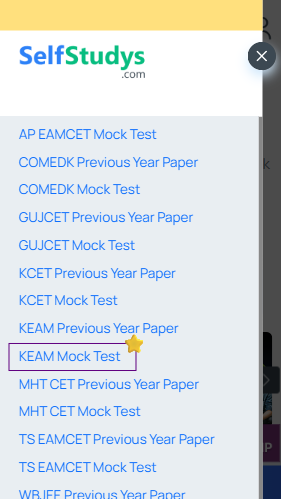
- Within a short interval, your browser will open up a new page wherein you can choose a KEAM online mock test free from any subject.
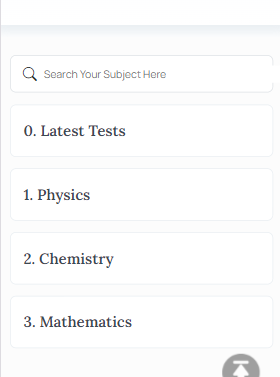
- A series of KEAM mock test free under your chosen subject will open up and you can click on the ‘Start Test’ icon of anyone.
- Lastly, you should read the KEAM mock test 2025 instructions carefully for a successful attempt.
Note: It is important to Sign Up or Log In with your Google account on SelfStudys if you wish to check the result of your attempt at the KEAM online mock test.
What Are The Topics From Which KEAM Mock Test Series Is Created?
The KEAM mock test series on SelfStudys includes all the topics that are prescribed in the official syllabus of the Kerala Engineering, Architecture, and Medical Entrance Exam. Generally, the standard of this examination is the same as Higher Secondary or equivalent examination. You can have a look at the table below to learn which topics are included in our mock tests.
|
KEAM EXAM TOPICS FROM MATHS SUBJECT |
|
|
Name of the Unit |
Included Topics |
|
ALGEBRA |
Sets, Relations, and Functions Sets and their representations: Finite and Infinite sets; Empty set; Equal sets; Subsets; Power set; Universal set; Venn Diagrams; Complement of a set; Operations on Sets (Union, Intersection, and Difference of Set); Applications of sets: Ordered Pairs, Cartesian Product of Two sets; Relations, reflexive, symmetric, transitive and equivalence relations. Domain, Co-domain, and Range. |
|
Complex Numbers Complex Numbers in the form; Real and Imaginary Parts of a Complex Number; Complex Conjugate, Argand Diagram, Representation of Complex Number as a point in the plane; Modulus and Argument of a Complex Number; Algebra of Complex Numbers; Triangle Inequality. |
|
|
Sequences and Series Sequence and Examples of Finite and Infinite Sequences; Arithmetic Progression (A..P): First Term, Common Difference, nth Term and sum of n terms of an A.P.; Arithmetic Mean (A.M); Insertion of Arithmetic Means between any Two given Numbers; Geometric Progression (G.P): first Term, Common Ratio and nth term, Sum to n Terms, infinite GP and its sum. Geometric Mean (G.M). |
|
|
Permutations, Combinations, Binomial Theorem and Mathematical Induction Fundamental Principle of Counting; The Factorial Notation; Permutation as an Arrangement; Meaning of P(n, r); Combination: Meaning of C(n,r); Applications of Permutations and Combinations. Statement of Binomial Theorem; General and Middle Terms in Binomial Expansions. The Principle of Mathematical Induction, simple Applications. |
|
|
Matrices and Determinants Concept of a Matrix; Types of Matrices; Equality of Matrices (only real entries may be considered): Operations of Addition, Scalar Multiplication and Multiplication of Matrices; Statement of Important Results on operations of Matrices and their Verifications by Numerical Problem only; Determinant of a Square Matrix; Minors and Cofactors; singular and non-singular Matrices; Applications of Determinants in finding the Area of a Triangle. |
|
|
TRIGONOMETRY |
Trigonometric functions and Inverse Trigonometric functions Degree measures and Radian measure of positive and negative angles; the relation between degree measure and radian measure, the definition of trigonometric functions with the help of a unit circle, periodic functions, the concept of periodicity of trigonometric functions, the value of trigonometric functions of x; trigonometric functions of sum and difference of numbers. |
|
Trigonometric functions of multiple and submultiples of numbers Conditional identities for the angles of a triangle, solution of trigonometric equations of the type Sin x = Sin a; Cos x = Cos a; Tan x = Tan a, and equations reducible to these forms. Proofs and simple application of sine and cosine formulae.Inverse Trigonometric functions. Range, domain, principal value branch, and graphs of inverse trigonometric functions. |
|
|
GEOMETRY |
Lines and Family of lines Cartesian system of coordinates in a plane, shifting of origin. Distance formula, Slope of line, parallel and perpendicular lines. Various forms of equations of a line parallel to axes, slope intercept form, Slope point form, Intercept form, Normal form, General form, and Intersection of lines. Equation of bisectors of the angle between two lines. |
|
Vectors Vectors and scalars, Magnitude and Direction of a vector, Types of vectors (Equal vectors, unit vector, Zero vector). Position vector of a point, Localized and free vectors, parallel and collinear vectors, Negative of a vector, components of a vector, Addition of vectors, multiplication of a vector by a scalar, position vector of point dividing a line segment in a given ratio, Application of vectors in geometry. Scalar product of two vectors, projection of a vector on a line, vector product of two vectors. |
|
|
Three-Dimensional Geometry Coordinate axes and coordinate planes in three-dimensional space, coordinate a point in space, distance between two points, section formula, direction cosines, and direction ratios of a line joining two points, projection of the join of two points on a given line, Angle between two lines whose direction ratios are given. |
|
|
CALCULUS |
Functions, Limits, and Continuity |
|
Application of Derivatives Rate of change of quantities; Tangents and Normals; increasing and decreasing functions and sign of the derivatives; maxima and minima; Greatest and least values; Rolle's theorem and Mean value theorem; Approximation by differentials. Simple problems. |
|
|
Linear Programming Introduction, related terminology such as constraints, Objective function, optimization, different types of linear programming problems, mathematical formulation of Linear Programming Problems, graphical method of solution for problems in two variables, feasible and infeasible regions, feasible and infeasible solutions, optimal feasible solutions (up to three non-trivial constraints). |
|
|
PHYSICS SUBJECT KEAM EXAM TOPICS |
|
|
PHYSICAL WORLD AND MEASUREMENT |
Physics: Scope and excitement; nature of physical laws; Physics, technology, and society. Need for measurement: Units of measurement; systems of units; SI units, fundamental and derived units. Length, mass, and time measurements; accuracy and precision of measuring instruments; errors in measurement; significant figures. |
|
KINEMATICS |
Frame of reference, Motion in a straight line: Position-time graph, speed, and velocity. Uniform and non-uniform motion, average speed, and instantaneous velocity. Uniformly accelerated motion, velocity-time, and position-time graphs, relations for uniformly accelerated motion (graphical treatment). |
|
LAWS OF MOTION |
Intuitive concept of force. Inertia, Newton’s first law of motion; momentum and Newton’s second law of motion; impulse; Newton’s third law of motion. Law of conservation of linear momentum and its applications. |
|
THERMODYNAMICS |
Thermal equilibrium and definition of temperature (zeroth law of Thermodynamics). Heat, work, and internal energy. The first law of thermodynamics. Isothermal and adiabatic processes. The second law of thermodynamics: Reversible and irreversible processes. Heat engines and refrigerators. |
|
ELECTROSTATICS |
Electric charges and their conservation. Coulomb’s law – force between two point charges, forces between multiple charges. Electric field, electric field due to a point charge, electric field lines; electric dipole. Electric flux, statement of Gauss’s theorem and its applications to find field due to infinitely long uniformly charged straight wire. |
|
OPTICS |
Reflection of light, spherical mirrors, mirror formula. Refraction of light, total internal reflection, optical fibers, refraction at spherical surfaces, lenses, thin lens formula, lens-maker’s formula. Magnification, power of a lens, combination of thin lenses in contact combination of a lens and a mirror. Refraction and dispersion of light through a prism. Scattering of light. Optical instruments: Human eye. Microscopes and astronomical telescopes and their magnifying powers. |
|
ATOMS AND NUCLEI |
Alpha-particle scattering experiment; Rutherford’s model of atom; Bohr model, energy levels, hydrogen spectrum. Composition and size of nucleus, atomic masses, isotopes, isobars; isotones. Radioactivity – alpha, beta, and gamma particles/rays and their properties; radioactive decay law. |
|
ELECTRONIC DEVICES |
Energy bands in solids (qualitative ideas only), conductors, insulators, and semiconductors; semiconductor diode – I-V characteristics in forward and reverse bias, diode as a rectifier; I-V characteristics of LED, photodiode, solar cell, and Zener diode; Zener diode as a voltage regulator. |
|
COMMUNICATION SYSTEMS |
Elements of a communication system (block diagram only); bandwidth of signals (speech, TV, and digital data); bandwidth of transmission medium. Propagation of electromagnetic waves in the atmosphere, sky, and space wave propagation. Need for modulation. Production and detection of an amplitude-modulated wave. |
|
KEAM EXAM TOPICS FROM CHEMISTRY SUBJECT |
|
|
SOME BASIC CONCEPTS OF CHEMISTRY |
General Introduction: Importance and scope of chemistry. Historical approach to particulate nature of matter, laws of chemical combination, Dalton’s atomic theory: the concept of elements, atoms, and molecules. Atomic and molecular masses. Mole concept and molar mass; percentage composition and empirical and molecular formula; chemical reactions, stoichiometry, and calculations based on stoichiometry. |
|
CLASSIFICATION OF ELEMENTS AND PERIODICITY IN PROPERTIES |
Significance of classification, a brief history of the development of the periodic table, modern periodic law and the present form of the periodic table, periodic trends in properties of elements –atomic radii, ionic radii, inert gas radii, ionization enthalpy, electron gain enthalpy, electronegativity, valence. Nomenclature of elements with atomic number greater than 100. |
|
CHEMICAL BONDING AND MOLECULAR STRUCTURE |
Valence electrons, ionic bond, covalent bond, bond parameters, Lewis structure, polar character of covalent bond, covalent character of ionic bond, valence bond theory, resonance, geometry of covalent molecules, VSEPR theory, concept of hybridization involving s, p and d orbitals and shapes of some simple molecules, molecular orbital theory of homonuclear diatomic molecules. Hydrogen bond. |
|
STATES OF MATTER: GASES, LIQUIDS, AND SOLIDS |
Three states of matter, intermolecular interactions, types of bonding, melting and boiling points, the role of gas laws in elucidating the concept of the molecule, Boyle’s law, Charle’s law, Gay Lussac’s law, Avogadro’s law, ideal behavior, empirical derivation of gas equation, Avogadro number, ideal gas equation. Kinetic energy and molecular speeds (elementary idea), deviation from ideal behavior, liquefaction of gases, critical temperature. |
|
THERMODYNAMICS |
Concepts of system, types of systems, surroundings, work, heat, energy, extensive and intensive properties, state functions. The first law of thermodynamics – internal energy and enthalpy, heat capacity, and specific heat, measurement of ΔU and ΔH, Hess’s law of constant heat summation, enthalpy of bond dissociation, combustion, formation, atomization, sublimation, phase transition, ionization, solution, and dilution. Introduction of entropy as a state function, Second law of thermodynamics, Gibbs energy change for spontaneous and non-spontaneous process, criteria for equilibrium. Third law of thermodynamics –Brief introduction. |
|
EQUILIBRIUM |
Equilibrium in physical and chemical processes, dynamic nature of equilibrium, law of mass action, equilibrium constant, factors affecting equilibrium – Le Chatelier’s principle; ionic equilibrium – ionization of acids and bases, strong and weak electrolytes, degree of ionization, ionization of polybasic acids, acid strength, concept of pH., Hydrolysis of salts. |
|
REDOX REACTIONS AND ELECTROCHEMISTRY |
Concept of oxidation and reduction, redox reactions, oxidation number, balancing redox reactions in terms of loss and gain of electron and change in oxidation numbers, applications of redox reactions. Conductance in electrolytic solutions, specific and molar conductivity variations of conductivity with concentration, Kohlrausch’s Law, electrolysis and laws of electrolysis, dry cell – electrolytic cells and Galvanic cells; lead accumulator. |
|
SOLUTIONS |
Types of solutions, expression of concentration of solutions of solids in liquids, the solubility of gases in liquids, solid solutions, colligative properties – the relative lowering of vapor pressure, Raoult’s law, the elevation of B.P., depression of freezing point, osmotic pressure, determination of molecular masses using colligative properties, abnormal molecular mass, Vant Hoff factor. |
|
CHEMICAL KINETICS |
Rate of a reaction (average and instantaneous), factors affecting rates of reaction: concentration, temperature, catalyst; order and molecularity of a reaction; rate law and specific rate constant, integrated rate equations, and half-life; the concept of collision theory. Activation energy, Arrhenius equation. |
|
SURFACE CHEMISTRY |
Adsorption – physisorption and chemisorption; factors affecting adsorption of gases on solids; catalysis: homogenous and heterogeneous, activity and selectivity: enzyme catalysis; colloidal state: distinction between true solutions, colloids and suspensions; lyophillic, lyophobic multimolecular and macromolecular colloids; properties of colloids; Tyndall effect, Brownian movement, electrophoresis, coagulation; emulsions – types of emulsions. |
|
BIOMOLECULES |
Carbohydrates – Classification, monosaccharide, DL configuration, oligosaccharides, polysaccharides: importance. Proteins - Elementary idea of a-amino acids, peptide bonds, polypeptides, proteins, primary structure, secondary structure, tertiary structure, and quaternary structure, denaturation of proteins; enzymes. Hormones. Vitamins – Classification and functions. Nucleic Acids: DNA and RNA. |
|
POLYMERS |
Classification – Natural and synthetic, methods of polymerization, copolymerization. Some important polymers: are natural and synthetic like polythene, nylon, polyesters, bakelite, and rubber. Biodegradable and non-biodegradable polymers. |
KEAM Entrance Exam Trends Analysis For Engineering Courses
In this section, we have described a detailed analysis of the KEAM exam for the Engineering field in the past 5 years. Our team of highly professional educators has analyzed the trends in the exam for these previous years by considering different factors.
KEAM Physics Examination
You can check out the table mentioned below for more information on the analysis of Physics subjects in the KEAM examination.
|
YEAR |
TOTAL APPLICANTS |
GOOD ATTEMPTS |
% OF STUDENTS PASSED |
HIGHEST SCORE |
AVERAGE SCORE |
|
2019 |
85,231 |
62,413 |
73.2% |
98 |
75.2 |
|
2020 |
90,154 |
66,954 |
74.3% |
99 |
76.4 |
|
2021 |
92,781 |
69,288 |
74.7% |
99 |
77.1 |
|
2022 |
94,612 |
71,643 |
75.7% |
100 |
78.3 |
|
2023 |
96,503 |
74,451 |
77.1% |
100 |
79.5 |
KEAM Examination For Chemistry
The details for the analysis of the Chemistry subject in the Kerala Engineering, Architecture, and Medical Entrance Exam are given in the table below.
|
YEAR |
TOTAL APPLICANTS |
GOOD ATTEMPTS |
% OF STUDENTS PASSED |
HIGHEST SCORE |
AVERAGE SCORE |
|
2019 |
85,231 |
60,291 |
70.8% |
97 |
72.6 |
|
2020 |
90,154 |
64,757 |
71.9% |
98 |
73.8 |
|
2021 |
92,781 |
67,244 |
72.5% |
99 |
75.4 |
|
2022 |
94,612 |
69,806 |
73.7% |
99 |
75.7 |
|
2023 |
96,503 |
72,432 |
75.1% |
100 |
77.1 |
KEAM Maths Examination
For the analysis of the Maths subject in the KEAM exam, you should go through the table described below.
|
YEAR |
TOTAL APPLICANTS |
GOOD ATTEMPTS |
% OF STUDENTS PASSED |
HIGHEST SCORE |
AVERAGE SCORE |
|
2019 |
85,231 |
58,412 |
68.5% |
95 |
70.1 |
|
2020 |
90,154 |
62,731 |
69.7% |
97 |
71.4 |
|
2021 |
92,781 |
65,122 |
70.2% |
98 |
72.1 |
|
2022 |
94,612 |
67,719 |
71.6% |
99 |
73.5 |
|
2023 |
96,503 |
70,329 |
72.9% |
99 |
74.8 |
Insights Into The Past 5 Year Exam Trends
Our team at SelfStudys has also shared some insights that they noticed in these past years’ KEAM exams.
- A steady increase in total applicants: There has been a steady increase in the number of applicants from the year 2019 to 2023. This reflects the growing popularity and competitiveness of the Kerala Engineering, Architecture, and Medical Entrance Exam.
- Improvement in pass percentages: Across the subjects of Physics, Maths, and Chemistry, our experts have seen that the percentage of students who passed this examination has also increased.
- Higher scores and averages: We have also checked that the highest scores achieved by the candidates have improved significantly. The maximum score in both Physics and Chemistry reached 100 in 2022 as well as 2023. This indicates an overall improvement in the student’s performance.
- Less gap between subjects: The above tables clearly show that Maths has been the most challenging subject. But, over the years, the gap between the performance in Maths and the other two subjects has gradually decreased.
Important Information Related To The KEAM Examination
The Office of the Commissioner for Entrance Examinations, Kerala wants you to know about some important points regarding the KEAM examination. For this, you can check out the image displayed below.

Special Instructions For The Kerala Engineering, Architecture, and Medical Entrance Exam
For your reference, the instructions that you must be aware of for taking the KEAM exam are mentioned in detail below. In case, you don’t know about these instructions, then your performance in the exam will be affected.
Reporting For The KEAM Examination and General Instructions
- You need to reach the exam center at least 2 hours before the KEAM exam starts. You will be prohibited from entering the exam hall if you do not report at the center on time.
- You will be allotted a seat inside the hall once your biometric verification is completed. Your seat number will be displayed at the bottom-left corner of the login screen.
- You can only take your KEAM exam admit card, photo ID, and a ballpoint pen to the exam hall. You will get the paper sheets for rough work and you have to write your name, and roll number, and put your signature on the sheet. You need to return this sheet to the Invigilator after the examination.
- You are not allowed to use the keyboard during the entire examination. A virtual keyboard will appear on your computer screen where its use is necessary.
- You will immediately get a new computer system in case your allotted computer or mouse doesn’t work during the exam. The time wasted in this process will be adjusted in the server so that you get the full allocated time.
- You can leave the examination hall only once the entire exam is completed.
Guidelines For Computer Based Test
- Once your biometric and facial image is captured, you can go and sit on your allocated seat. You need to ensure that the seat number displayed on the computer screen is the same as the allotted one.
- You have to enter your roll number by using the virtual keyboard and mouse on the candidate login barrier in the login screen. Then, you should click on the ‘Submit’ button to begin with the Computer Based Test.
- After the roll number validation, you have to enter a secret code to complete the login process. The secret code will be given to you only after the roll number validation in the examination hall.
- Now, you can read some general instructions carefully and verify your name, roll number, and photo on this page.
- There will be a familiarization session (KEAM mock test) before the examination starts. You can practice and familiarise yourself with the format during this time. This mock test will be held for 15 minutes.
- A countdown timer will be visible in the top right corner, indicating the time left to start the KEAM mock test 2025.
- After the timer hits zero, the page will get redirected to the KEAM online mock test page automatically.
- The actual examination page will open up once the timer on the KEAM mock test hits zero.
- You can attend the actual test after the KEAM mock test 2025 time is finished. An information panel will be provided on the top of the screen that will indicate total questions, answered questions, and the time remaining for the examination.
- Below the information panel, the Question Block will be displayed to show the question and options. Questions as well as the answer options will be displayed one by one on your screen.
- A Navigation Panel is provided just below the Question block to capture your responses:
- The “Save and Next” button will save the selected option and navigate to the next question.
- The “Save and Previous” button will save the selected option and navigate to the previous question.
- The “Clear Response” button will clear the selected option/response.
- The “Mark/Unmark for Review” button click will Mark the question for review or unmark the marked question (if the question is already marked for review).
- The Computer-Based Test will redirect to the “Exam Statistics” page once the time is over, where you can view the statistics of the examination.
- Once you have seen the Statistics, you can leave the exam hall as there is no need to end or submit the exam.
Study Tactics To Help In Conceptual Learning For The KEAM Mock Test
If you wish to increase your conceptual learning for an attempt at the KEAM online mock test free, then you can follow the tactics mentioned below.
- When you are planning to take the KEAM mock test, you should not just cram facts or formulas. It is essential that you dig deeper to learn the underlying concepts and principles. You can develop the habit of asking yourself ‘why’ and ‘how’ things work. Moreover, you should visualize the concepts through diagrams, mind maps, or graphs.
- Instead of attempting the KEAM mock test free to only measure your performance, you should use it for enhanced learning. In this way, you can analyze your mistakes after each test and understand why you solved a particular question incorrectly. Then, you can revise the related concepts and practice similar types of problems in order to strengthen your knowledge.
- You must always remember that the KEAM mock test 2025 is just a simulation of the exam. So, you need to stay calm and focused while attempting it. With the help of these tests, you have to develop a time management strategy in which you can allocate proper time to each section.
- You will be able to actively recall information by creating flashcards and using them to test yourself. You can include key concepts, formulas, and even common mistakes that you make in these flashcards.
- Focusing on solving the problems that you found difficult in the past KEAM online mock test is a great tactic. Because this way, you can bridge the gaps in your knowledge and build your targeted strengths.
- One more effective technique that you can use is to create a ‘wrong question bank.’ In this bank, you can collect all the questions that you answered incorrectly in the KEAM mock test series. By engaging with this question bank, you can easily recognize recurring problems and work on them significantly.
- The subject-matter experts at SelfStudys do not recommend you attempt the KEAM online mock test free back to back. You should keep spaced repetition in mind and then schedule the test attempts. In this way, your brain gets time to solidify the information which improves your recalling powers in the next test.
- You can turn the KEAM mock test into a game by pairing and competing with a friend. You may award points to each other for correct responses and deduct them for incorrect ones. By doing so, you can add a fun element to your studying and stay motivated for a longer period.
How Is The KEAM Exam Rank List Prepared for Engineering Courses?
For every undergraduate stream, there are different rank lists prepared for the KEAM exam by the authority. You can have a look at the images displayed below for further information on the rank lists of engineering courses.
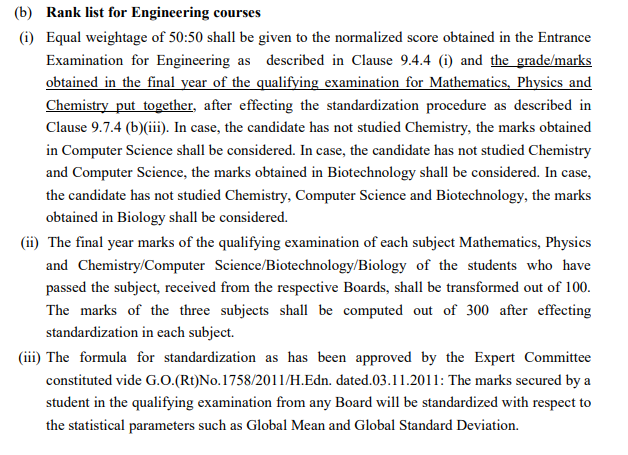
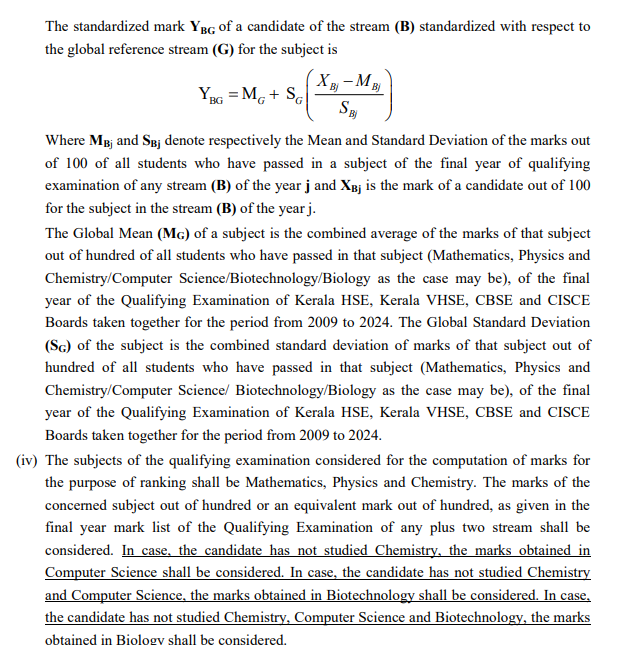
Which Are The Best Engineering Colleges That Accept The KEAM Exam Score?
All around the state of Kerala, there are numerous engineering colleges that offer admission into different courses based on your score in the KEAM examination. Check out the table below for more details on the best engineering colleges.
|
KEAM ENGINEERING COLLEGES UNDER THE DIRECTOR OF TECHNICAL EDUCATION |
|||
|
CODE |
COLLEGE NAME |
COURSES OFFERED AND NUMBER OF SEATS |
TOTAL SEATS |
|
IDK |
Govt. Engineering College, Painavu, Idukki |
CS-60, EC-60, EE-60, IT-60, ME-60 |
300 |
|
KKE |
Govt. Engineering College, Kozhikode |
AE-60, CE-60, CH-60, ME-60, EC – 60, CG-60 |
360 |
|
KNR |
Govt.College of Engineering, Kannur |
CE-60, CS-60, EC-90, EE-60, ME-60 |
330 |
|
KTE |
Rajiv Gandhi Institute of Technology, Pampady, Kottayam |
AR-40, CE-60, CS-60, EC-60, EE-60, ME-60, RA-30 |
370 |
|
PKD |
Govt. Engineering College, Sreekrishnapuram, Palakkad |
CS-60, EC-60, EE-60, IT-60, ME-60, CE-60 |
360 |
|
TCR |
Govt. Engineering College, Thrissur |
CE-20, CH-60, CS-60, EC-60, EE-120, ME-120, PE-60, AR-40 |
640 |
|
TRV |
Govt. Engineering College, Barton Hill, Thiruvananthapuram |
CE -60, EC-60, EE-60, IT-60, ME-60 |
300 |
|
TVE |
College of Engineering, Thiruvananthapuram |
AE- 60, AR-40, CE-120, CS-120, EC-60, EE-120, IE-60, ME-120 |
700 |
|
WYD |
Govt. Engineering College, Mananthavady, Wayanad |
CS-60, EC-120, EE-60, ME-60, CV-30 |
330 |
|
MAC |
Mar Athanasius College of Engineering, Kothamangalam, Ernakulam |
CE-120, CS-60, EC-120, EE-120, ME-120, CO60, AH-60 |
660 |
|
NSS |
N.S.S.College of Engineering, Akathethara P O, Palakkad |
CE-120, CS-60, EC-120, EE-120, IC-60, ME-120 |
600 |
|
TKM |
T.K.M. College of Engineering, Kollam |
CE-120, CH-60, CS-120, EC-120, EE-120, ME-180, AR-80, EL-60 |
860 |
|
GOVERNMENT COST-SHARING ENGINEERING COLLEGES UNDER THE INSTITUTE OF HUMAN RESOURCES DEVELOPMENT(IHRD) |
|||
|
ADR |
College of Engineering, Adoor, Pathanamthitta |
CS-120, EC-60, EE-60, ME-60, CO-6 |
360 |
|
CEA |
College of Engineering, Attingal, Thiruvananthapuram |
CS-120, EC-60, EE-60, CL -60 |
300 |
|
CEC |
College of Engineering, Pallippuram, Cherthala, Alappuzha |
CS-120, EC-60, EE-30, AD-60 |
270 |
|
CEK |
College of Engineering, Kottarakkara, Kollam |
CS-120, EC-30, CL-60 |
210 |
|
CHN |
College of Engineering, Chengannur, Alappuzha |
CS-180, EC-120, EE-60 |
360 |
|
GOVERNMENT COST-SHARING ENGINEERING COLLEGES UNDER THE CO-OPERATIVE ACADEMY OF PROFESSIONAL EDUCATION (CAPE) |
|||
|
AEC |
College of Engineering, Aranmula, Pathanamthitta |
CE-60, CS-60 |
120 |
|
CEM |
College of Engineering, Muttathara, Thiruvananthapuram |
CE-60, CS-60, EC-60, EE-60, ME-60 |
300 |
|
KGR |
College of Engineering, Kidangoor, Kottayam |
CE-60, CS-120, EC-60, EE-30 , EL-30 |
300 |
|
PEC |
College of Engineering, Pathanapuram, Kuriottumala, Elikattor P O, Kollam |
CE-60, CS-60, ME-60 |
180 |
|
PRN |
College of Engineering, Perumon, Kollam |
CS-120, EC-120, EE-60, ME-60 |
360 |
|
PRIVATE SELF FINANCING COLLEGES |
|||
|
AAE |
Al-Azhar College of Engineering and Tech., Perumpillichira, Thodupuzha, Idukki |
AU-30, CE-60, CS-60, EC-30, ME-60, AH-60, CY-60 |
360 |
|
AAP |
Al-Ameen Engineering College, Shoranur, Palakkad |
CE-60, EC-30, EE-30, ME-30, CS-60, CY-60, AD-60 |
330 |
|
AIK |
Albertian Institute of Science and Technology, Kalamassery, Kochi |
CE-60, CS-120, EC-60, EE-60, ME-60 |
360 |
|
AME |
Rajadhani Institute of Science and Technology, Kannampariyaram, Mankara P O, Palakkad |
CE -60, CS-60, EC-30, EE-30, ME-60, CY-60, CL-60 |
360 |
|
ASI |
Adi Shankara Institute of Engineering and Technology, Kalady, Ernakulam |
CE-60, CS-180, CT-60, EC-90, EE-60, ME-60, RB-60, EB-60, CO-30 |
660 |
|
ATP |
Ahalia School of Engineering and Technology, Kozhippara, Pudussery, Palakkad |
CE-60, CS-120, EC-60, EE-60, ME-60 |
360 |
|
AWH |
AWH Engineering College, Kuttikkattoor, Kozhikode |
CE-60, CS-60, EC-30, EE-30, ME-60 |
240 |
|
BJK |
Bishop Jerome Institute, Fathima College Road, Kollam |
CE-60, EC-60, EE-60, ME-60, CS-60, CO-60 |
360 |
|
BMC |
Baselios Mathews II College of Engineering, Sasthamcotta, Kollam |
CE-30, CS-120, EC-30, EE-30, ME-30 , AI-60 |
300 |
|
CCE |
Christ College of Engineering, Irinjalakuda, Thrissur |
CE-60, CS-120, EC-60, EE-60, ME-60 |
360 |
Note: This list only includes some of the engineering colleges that provide admission into undergraduate courses through the Kerala Engineering, Architecture, and Medical Entrance Exam. For more details about the colleges, we advise you to visit the official website of the Office of the Commissioner for Entrance Examinations, Kerala.
Description Of KEAM Engineering Course Codes
You can go through the table given below to understand which codes represent the engineering course that you want to apply for through the KEAM exam.
|
Branch Code |
NAME OF THE ENGINEERING BRANCH |
Branch Code |
NAME OF THE ENGINEERING BRANCH |
|
AD |
Artificial Intelligence and Data Science |
AE |
Applied Electronics and Instrumentation |
|
AG |
B.Tech. (Agricultural Engineering) |
AH |
Artificial Intelligence and Machine Learning |
|
AI |
Artificial Intelligence |
AJ |
Agricultural Engineering |
|
AO |
Aeronautical Engineering |
AR |
Architecture |
|
AU |
Automobile Engineering |
BB |
Biotechnology and Biochemical Engineering |
|
BE |
Computer Science Engineering (Business Systems) |
BK |
Computer Science Engineering (Block Chain) |
|
BM |
Bio-Medical Engineering |
BT |
Bio-Technology |
|
CA |
Computer Engineering and Application |
CC |
Computer Engineering |
|
CE |
Civil Engineering |
CG |
Computer Science and Design |
|
CH |
Chemical Engineering |
CL |
Computer Science and Engineering (Artificial Intelligence and Machine Learning) |
|
CO |
Computer Science and Engineering (Data Science) |
CR |
Cyber Security |
|
CS |
Computer Science and Engineering |
CT |
Computer Science and Engineering (Artificial Intelligence) |
|
CU |
Computer Science and Business Systems |
CV |
Civil and Environmental Engineering |
|
CY |
Computer Science and Engineering (Cyber Security) |
DS |
Dairy Technology |
|
EA |
Electronics and Communication (Advanced Communication Technology) |
EB |
Electronics and Bio-Medical Engineering |
|
EC |
Electronics and Communication |
EE |
Electrical and Electronics |
|
EI |
Electronics and Instrumentation |
EL |
Electrical and Computer Engineering |
|
ES |
Electronics and Computer Engineering |
EV |
Electronics Engineering (VLSI Design and Technology) |
|
FS |
Safety and Fire Engineering |
FT |
Food Technology |
|
IB |
Computer Science and Engineering (Internet of Things and Cyber Security including Block Chain Technology) |
IC |
Instrumentation and Control Engineering |
|
ID |
Computer Science and Engineering (Artificial Intelligence and Data Science) |
IE |
Industrial Engineering |
|
IO |
Computer Science and Engineering (Internet of Things) |
IT |
Information Technology |
|
MA |
Mechanical (Automobile) |
ME |
Mechanical Engineering |
|
MG |
Metallurgical and Materials Engineering |
MP |
Mechanical (Production Engineering) |
|
MR |
Mechatronics Engineering |
MT |
Metallurgy |
|
PE |
Production Engineering |
PO |
Polymer Engineering |
|
PT |
Printing Technology |
RA |
Robotics and Artificial Intelligence |
|
RB |
Robotics and Automation |
SB |
Naval Architecture and Ship Building |







 Profile
Profile Signout
Signout










 Quiz
Quiz
 Get latest Exam Updates
Get latest Exam Updates 










